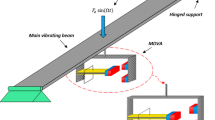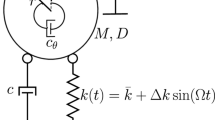Abstract
In this paper, a vibration-based testing methodology to assess fatigue behavior of a metallic structure is presented. To minimize the testing duration, the test setup is designed for a base-excited multiple-specimen arrangement driven in a high-frequency resonant mode, which allows completion of fatigue testing in an accelerated period. The shaker operates in closed-loop control with dynamic specimen response feedback provided by a scanning laser vibrometer. A test coordinator function is developed to synchronize the shaker controller and the laser vibrometer and complete the closed-loop scheme: the test coordinator monitors structural health of the test specimens throughout the test period, recognizes change in specimen dynamic behavior due to fatigue crack initiation, terminates test progression, and acquires test data in an orderly manner. The test methodology is demonstrated with cantilever specimens that are clasped on the shaker armature with specially-designed clamp fixtures. Experimental stress evaluation is carried out to verify the specimen stress predictions. A successful application of the experimental methodology is demonstrated by validation tests with Al 6061-T6 aluminum specimens subjected to fully-reversed bending stress.





















Similar content being viewed by others
References
George TJ, Seidt J, Shen MHH, Nicholas T, Cross CJ (2004) Development of a novel vibration-based fatigue testing methodology. Int J Fatigue 26(5):477–486. doi:10.1016/j.ijfatigue.2003.10.012
Wang YC, Hoechbauer T, Swadener JG, Misra A, Hoagland G, Nastasi M (2006) Mechanical fatigue measurement via a vibrating cantilever beam for self-supported thin solid films. Exp Mech 46(4):503–517. doi:10.1007/s11340-006-7556-4
Xue HQ, Tao H, Monternbault F, Wang QY, Bathias C (2007) Development of a three-point bending fatigue testing methodology at 20 kHz frequency. Int J Fatigue 29(9–11):2085–2093. doi:10.1016/j.ijfatigue.2007.03.018
Vanlanduit S, Verboven P, Guillaume P (2003) On-line detection of fatigue cracks using an automatic mode tracking technique. J Sound Vib 266(4):805–814. doi:10.1016/S0022-460x(02)01572-9
Vanlanduit S, Parloo E, Guillaume P (2004) An on-line combined linear-nonlinear fatigue crack detection technique. NDT and E Int 37(1):41–45. doi:10.1016/S0963-8695(03)00094-X
Joaquim FT, Barbieri R, Barbieri N (2009) Investigating torsional fatigue with a novel resonant testing fixture. Int J Fatigue 31(8–9):1271–1277. doi:10.1016/j.ijfatigue.2009.01.018
Oezsoy S, Celik M, Kadioglu FS (2008) An accelerated life test approach for aerospace structural components. Eng Fail Anal 15(7):946–957. doi:10.1016/j.engfailanal.2007.10.015
Rotem A (1981) Accelerated fatigue testing method. Int J Fatigue 3(4):211–215
Nieto AJ, Chicharro JM, Pintado P (2006) An approximated methodology for fatigue tests and fatigue monitoring of concrete specimens. Int J Fatigue 28(8):835–842. doi:10.1016/j.ijfatigue.2005.11.004
Kim CY, Song JH, Lee DY (2009) Development of a fatigue testing system for thin films. Int J Fatigue 31(4):736–742. doi:10.1016/j.ijfatigue.2008.03.010
Shen MHH, George T, Cross CJ, Calcaterra J (2007) Development of an improved high cycle fatigue criterion. J Eng Gas Turbines Power Trans Asme 129(1):162–169. doi:10.1115/1.2360599
Kim HY, Marrero TR, Yasuda HK, Pringle OA (1999) A simple multi-specimen apparatus for fixed stress fatigue testing. J Biomed Mater Res 48(3):297–300
Ay I, Sakin R, Okoldan G (2008) An improved design of apparatus for multi-specimen bending fatigue and fatigue behaviour for laminated composites. Mater Des 29(2):397–402. doi:10.1016/j.matdes.2007.01.017
Polytec Inc. Objecti Model Reference, Visual Basic Engine, PSV 8.3.
Kocaturk T (2005) Determination of the steady-state response of viscoelastically supported cantilever beam under sinusoidal base excitation. J Sound Vib 281(3–5):1145–1156. doi:10.1016/j.jsv.2004.03.028
Lee YL, Pan J, Hathaway RB, Barkey ME (2005) Fatigue testing and analysis (Theory and Practice). Elsevier, Burlington
Acknowledgements
The authors would like to proclaim sincere gratitude to all those who contributed to the success of the research project reported in this study. The authors appreciate the inspiration and support provided by Dick Shaltens, Wayne Wong, Jeff Schreiber, Lanny Thieme, and Geoff Bruder, as well as the technical management of Drs. Ajay Misra and Steven Arnold. The authors thank Ralph Pawlik and Frank Bremenour for their expert experimental advice and technical collaboration. The Science Mission Directorate at NASA Headquarters provided funding to complete the work described herein, and the authors truly are grateful for that enduring commitment. The authors highly appreciate the efforts and cooperation enjoyed from Sunpower, including the professional work of Kyle Wilson, Doug Mansfield, Courtney Lenart, and their consultant Barry Penswick. The authors also would like to thank Mr. Brett Bell, Mr. William Wenzel and Mr. Dale Ertley (all from College of Engineering, the University of Akron) for their strong support in manufacturing and machining of materials.
Author information
Authors and Affiliations
Corresponding author
Rights and permissions
About this article
Cite this article
Yun, G.J., Abdullah, A.B.M. & Binienda, W. Development of a Closed-Loop High-Cycle Resonant Fatigue Testing System. Exp Mech 52, 275–288 (2012). https://doi.org/10.1007/s11340-011-9486-z
Received:
Accepted:
Published:
Issue Date:
DOI: https://doi.org/10.1007/s11340-011-9486-z




